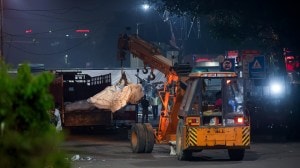More gas than action
Air pollution control is such a new subject for the country's bureaucrats and politicians that almost all of them are at sea. However, pus...

Air pollution control is such a new subject for the country’s bureaucrats and politicians that almost all of them are at sea. However, pushed by the courts, they are now running around like headless chickens. When ignorance and incompetence prevail, vested interests have a field day.
Confusion today is the hallmark of the Delhi government over the Supreme Court order to convert buses to CNG. One day newspapers report that its transport minister has asked the Union surface transport minister to assess the effectiveness of CNG because he is worried about conversion costs and the safety of CNG in Delhi’s heat. But the next day Delhi’s chief minister says her government is serious about CNG.
Meanwhile, rumours are afloat that some Harvard study has landed on the desks of Delhi officials that CNG buses emit nanoparticles’, and as tiny particles are dangerous to health, even CNG is bad. Not surprisingly, it’s been two months since the Supreme Court asked for an undertaking and an action plan for the conversion of eight-year-old buses but nothing has been submitted as yet. The hand of the powerful diesel lobby cannot be discounted. Some of the companies have been constantly arguing against CNG saying that the cheaper EURO II diesel buses would be a better buy. Today, bus manufacturers produce only EURO I buses, a standard that was applied in Europe in 1992. As a result, the Delhi government, lacking its own knowledge and conviction, just cannot seem to make up its mind.
How correct are these concerns anyway? Let us shift fact from fiction. By 1997, there were 1.05 million natural gas vehicles operating of which 28 per cent were in Italy, one of the most polluted countries of Europe, and another 8 per cent in USA. Since then both Los Angeles and New York city officials have publicly decided to push for CNG buses. Now there is pressure on Washington DC to do the same. In fact, of the 2,794 CNG refuelling stations in the world, over 39 per cent were in USA in 1997.
The key reason for moving towards CNG is to cut particulate pollution in Delhi which is extremely high and way above that of any western country. If European countries have been pushing diesel, it is because many politicians believed it to be an efficient fuel. But the European experience is utterly irrelevant to India because particulate pollution is extremely low there compared to ours and pro-diesel policies were formulated there when scientists knew much less about the danger of fine particles emitted by diesel. A recent study on diesel vehicles in Europe conducted by the authoritative International Energy Agency clearly says that with public health effects of diesel now becoming better known, environment and public health agencies are opposing the promotion of diesel vehicles.
Industry-generated confusion over air pollution control strategies is not exclusive to India. In April this year, the US Department of Energy (DOE) had to issue a press release entitled Natural Gas Buses: Separating Myth from Fact’ to counter what it calls “industry folklore” which should be a compulsory read for every bureaucrat who has doubts about CNG. The release deals with every issue that is confusing Indian decision-makers: cost, effect on global warming, safety or ultra-fine particles.
On the question of cost, the release points out that while the capital cost of a diesel bus is lower than that of a CNG bus, the operating cost is lower for a CNG bus in USA. This is true for India as well. Whereas the fuel cost for diesel buses is around Rs 4.01 per kilometre, for converted CNG buses around Rs 3.64, and for new CNG buses Rs 3.24.
The release dismisses the argument that CNG buses emit more particulate matter, pointing out, “CNG buses consistently emit dramatically less particulate matter than diesel buses. The trace amount of particulate matter associated with CNG is attributed to crankcase lubricating oil consumption (which also occurs in diesel engines).”
What about safety and proneness to explosions? The US DOE argues, “There is no evidence that CNG buses pose any greater risk of fire or explosion than diesel buses.” This makes common sense because both are highly inflammable material.
It is clear that moving to CNG is not an insurmountable problem. The Delhi government must grasp the nettle and keep vested interests at bay.



- 01
- 02
- 03
- 04
- 05




























